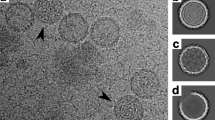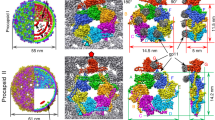Abstract
The Semliki Forest virus capsid protein contains a chymotrypsin-like protease domain that must fold before it can autocatalytically cleave the protein from a larger polyprotein precursor. Here we analyse this cleavage in living mammalian and prokaryotic cells, and find that it occurs immediately after the emergence of the protease domain from the ribosome during protein synthesis. The acquisition of the native conformation of this domain thus occurs rapidly and at the same time as translation. It does not require termination of translation or release from the ribosome, and nor does it involve Hsp70 binding. These results provide direct evidence that protein folding can occur co-translationally in the cytosol of both prokaryotes and eukaryotes.
This is a preview of subscription content, access via your institution
Access options
Subscribe to this journal
Receive 12 print issues and online access
$209.00 per year
only $17.42 per issue
Buy this article
- Purchase on Springer Link
- Instant access to full article PDF
Prices may be subject to local taxes which are calculated during checkout




Similar content being viewed by others
References
Anfinsen, C. B. & Scheraga, H. A. Experimental and theoretical aspects of protein folding. Adv. Protein Chem. 29, 205–300 ( 1975).
Fedorov, A. N. & Baldwin, T. O. Cotranslational protein folding . J. Biol. Chem. 272, 32715– 32718 (1997).
Netzer, W. J. & Hartl, F. U. Protein folding in the cytosol: chaperonin-dependent and independent mechanisms. Trends Biochem. Sci. 23, 68–73 ( 1998).
Hardesty, B., Tsalkova, T. & Kramer, G. Co-translational folding. Curr. Opin. Struct. Biol. 3, 1039–1045 ( 1999).
Bergman, L. W. & Kuehl, W. M. Formation of an intrachain disulfide bond on nascent immunoglobulin light chains. J. Biol. Chem. 254, 8869–8876 (1979).
Peters, T. Jr & Davidson, L. K. The biosynthesis of rat serum albumin. In vivo studies on the formation of the disulfide bonds. J. Biol. Chem. 257, 8847–8853 (1982).
Morrison, T. G. & McGinnes, L. W. Role of cotranslational disulfide bond formation in the folding of the hemagglutinin-neuraminidase protein of Newcastle disease virus. Virology 224, 465–476 (1996).
Chen, W., Helenius, J., Braakman, I. & Helenius, A. Cotranslational folding and calnexin binding during glycoprotein synthesis . Proc. Natl Acad. Sci. USA 92, 6229– 6233 (1995).
Beckmann, R. P., Mizzen, L. A. & Welch, W. J. Interaction of hsp70 with newly synthesized proteins: implications for folding and assembly. Science 248, 850–853 (1990).
Netzer, W. J. & Hartl, F. U. Recombination of protein domains facilitated by co-translational folding in eukaryotes. Nature 388, 343–349 (1997).
Kudlicki, W., Chirgwin, W., Kramer, G. & Hardesty, B. Folding of an enzyme into an active conformation while bound as peptidyl-tRNA to the ribosome . Biochemistry 34, 14284– 14287 (1995).
Fedorov, A. N., Friguet, B., Djavadi-Ohaniance, L., Alakhov, Y. B. & Goldberg, M. E. Folding on the ribosome of Escherichia coli tryptophan synthase beta subunit nascent chains probed with a conformation-dependent monoclonal antibody. J. Mol. Biol. 228, 351–358 ( 1992).
Kolb, V. A., Makeyev, E. V. & Spirin, A. S. Folding of firefly luciferase during translation in a cell-free system. EMBO J. 13, 3631– 3637 (1994).
Frydman, J., Nimmesgern, E., Ohtsuka, K. & Hartl, F. H. Folding of nascent polypeptide chains in a high molecular mass assembly with molecular chaperones. Nature 370, 111– 117 (1994).
Fedorov, A. N. & Baldwin, T. O. Contribution of cotranslational folding to the rate of formation of native protein structure . Proc. Natl Acad. Sci. USA 92, 1227– 1231 (1995).
Strauss, J. H. & Strauss, E. G. The alphaviruses: gene expression, replication, and evolution. Microbiol. Rev. 58, 491–562 (1994).
Choi, H. K. et al. Structure of Sindbis virus core protein reveals a chymotrypsin-like serine proteinase and the organization of the virion. Nature 354, 37–43 (1991).
Choi, H. K., Lu, G., Lee, S., Wengler, G. & Rossmann, M. G. Structure of Semliki Forest virus core protein. Proteins 27, 345–359 ( 1997).
Hahn, C. S., Strauss, E. G. & Strauss, J. H. Sequence analysis of three Sindbis virus mutants temperature-sensitive in the capsid protein autoprotease. Proc. Natl Acad. Sci. USA 82, 4648–4652 (1985).
Melancon, P. & Garoff, H. Processing of the Semliki Forest virus structural polyprotein: role of the capsid protease. J. Virol. 61, 1301–1309 ( 1987).
Hahn, C. S. & Strauss, J. H. Site-directed mutagenesis of the proposed catalytic amino acids of the Sindbis virus capsid protein autoprotease . J. Virol. 64, 3069–3073 (1990).
Braakman, I., Hoover-Litty, H., Wagner, K. R. & Helenius, A. Folding of influenza hemagglutinin in the endoplasmic reticulum. J. Cell Biol. 114, 401–411 (1991).
Forsell, K., Suomalainen, M. & Garoff, H. Structure-function relation of the NH2-terminal domain of the Semliki Forest virus capsid protein. J. Virol. 69, 1556–1563 (1995).
Aliperti, G. & Schlesinger, M. J. Evidence for an autoprotease activity of Sindbis virus capsid protein. Virology 90, 366–369 (1978).
Purvis, I. J. et al. The efficiency of folding of some proteins is increased by controlled rates of translation in vivo. J. Mol. Biol. 193, 413–417 (1987).
Whitley, P., Nilsson, I. & von Heijne, G. A nascent secretory protein may traverse the ribosome/endoplasmic reticulum translocase complex as an extended chain. J. Biol. Chem. 271, 6241–6244 ( 1996).
Matlack, K. E. & Walter, P. The 70 carboxyl-terminal amino acids of nascent secretory proteins are protected from proteolysis by the ribosome and the protein translocation apparatus of the endoplasmic reticulum membrane. J. Biol. Chem. 270, 6170– 6180 (1995).
Nathans, D. Puromycin inhibition of protein synthesis: incorporation of puromycin into peptide chains. Proc. Natl Acad. Sci. USA 51, 585–592 (1964).
Eggers, D. K., Welch, W. J. & Hansen, W. J. Complexes between nascent polypeptides and their molecular chaperones in the cytosol of mammalian cells. Mol. Biol. Cell. 8, 1559–1573 ( 1997).
Teter, S. A. et al. Polypeptide flux through bacterial Hsp70: DnaK cooperates with trigger factor in chaperoning nascent chains. Cell 97, 755–765 (1999).
Grollman, A. P. & Stewart, M. L. Inhibition of the attachment of messenger ribonucleic acid to ribosomes. Proc. Natl Acad. Sci. USA 61, 719– 725 (1968).
Garoff, H., Simons, K. & Dobberstein, B. Assembly of the Semliki Forest virus membrane glycoproteins in the membrane of the endoplasmic reticulum in vitro. J. Mol. Biol. 124, 587–600 (1978).
Makeyev, E. V., Kolb, V. A. & Spirin, A. S. Enzymatic activity of the ribosome-bound nascent peptide. FEBS Lett. 378, 166– 170 (1996).
Greiser-Wilke, I., Moenning, V., Kaaden, O. R. & Figueiredo, L. T. Most alphaviruses share a conserved epitopic region on their nucleocapsid protein. J. Gen. Virol. 70, 743– 748 (1989).
Zahn, R. et al. Chaperone activity and structure of monomeric polypeptide binding domains of GroEL. Proc. Natl Acad. Sci. USA 93, 15024–15029 (1996).
Witholt, B. et al. An efficient and reproducible procedure for the formation of spheroplasts from variously grown Escherichia coli. Anal. Biochem. 74, 160–170 (1976).
Acknowledgements
We thank A. Mezzacasa and C. Schnatwinkel for assistance, and L. Ellgaard and M. Molinari for critically reading the manuscript. This work was supported by grants from the Swiss National Science Foundation and the Swiss Federal Institute of Technology-Zurich.
Correspondence and request for materials should be addressed to A.H.
Author information
Authors and Affiliations
Corresponding author
Rights and permissions
About this article
Cite this article
Nicola, A., Chen, W. & Helenius, A. Co-translational folding of an alphavirus capsid protein in the cytosol of living cells. Nat Cell Biol 1, 341–345 (1999). https://doi.org/10.1038/14032
Received:
Revised:
Accepted:
Published:
Issue Date:
DOI: https://doi.org/10.1038/14032
This article is cited by
-
Enhancing co-translational folding of heterologous protein by deleting non-essential ribosomal proteins in Pichia pastoris
Biotechnology for Biofuels (2019)
-
Accurate prediction of cellular co-translational folding indicates proteins can switch from post- to co-translational folding
Nature Communications (2016)
-
A strategy for co-translational folding studies of ribosome-bound nascent chain complexes using NMR spectroscopy
Nature Protocols (2016)
-
A structural ensemble of a ribosome–nascent chain complex during cotranslational protein folding
Nature Structural & Molecular Biology (2016)
-
Prediction of variable translation rate effects on cotranslational protein folding
Nature Communications (2012)



